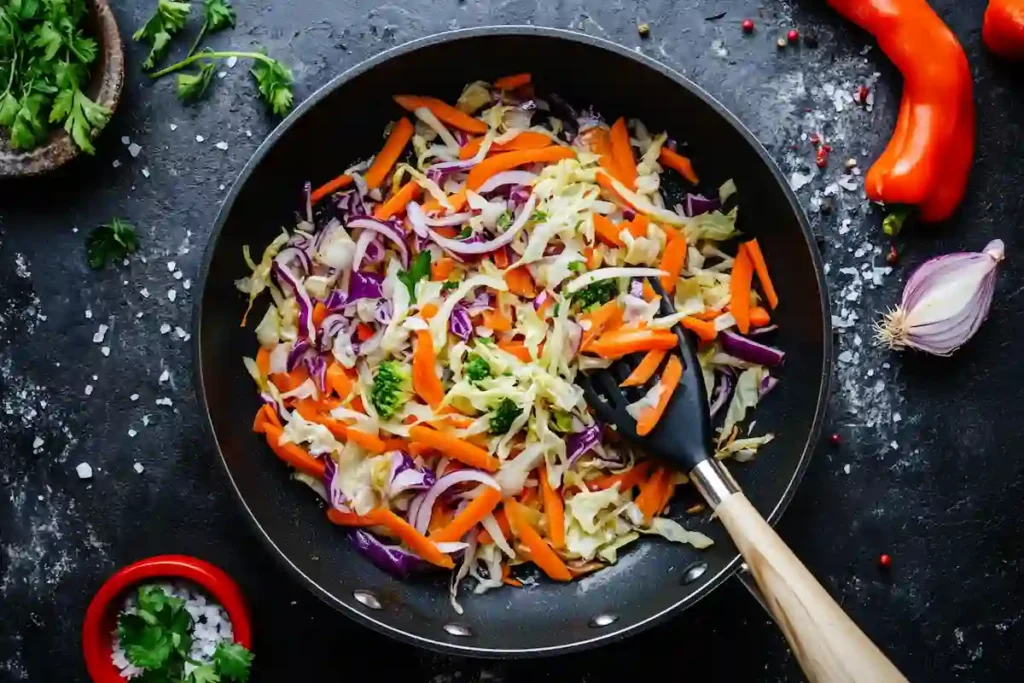Introduction
Egg rolls are a beloved treat, but one of the most common challenges people face is maintaining that perfect crunch from the first bite to the last. How do you make egg rolls not soggy if you want to savor every crispy layer without any disappointing sogginess? In this comprehensive guide, we’ll dive into every aspect of crafting crunchy, delicious egg rolls. From understanding the science behind sogginess to expert tips on fillings and frying methods, you’ll find everything you need to create mouthwatering results at home.
Egg rolls are typically wrapped in wheat-based wrappers and then fried or baked to a golden-brown color. When done right, the shell crackles pleasantly and the filling remains warm, fresh, and full of flavor. However, excess moisture can quickly turn your once-crunchy egg rolls limp. If you’ve ever wondered, “How do you make egg rolls not soggy?”, keep reading for proven techniques, insider secrets, and step-by-step instructions. With just a few simple adjustments, you can transform your homemade egg rolls into the star of any meal or party spread.
In this article, we’ll examine the pivotal factors that influence crunchiness, such as oil temperature, wrappers, fillings, and storage methods. Plus, we’ll explore advanced strategies to ensure your egg rolls stay tasty and crisp—even when prepared in large batches. Whether you’re making them for a family gathering, a potluck, or just to satisfy your cravings, these five crispy secrets will forever change the way you approach egg rolls.
1. Understanding Egg Rolls and Sogginess
The Anatomy of an Egg Roll
An egg roll comprises two primary parts: the wrapper and the filling. The wrapper is usually made from wheat flour, water, and salt, forming a dough that’s rolled out thin. The filling can vary, ranging from vegetables like cabbage and carrots to proteins such as chicken, shrimp, or tofu. Seasonings and sauces bring additional flavor dimensions.
When you ask, “How do you make egg rolls not soggy?”, it’s important to understand how moisture interacts with these components. Any residual water in the filling or uneven wrapper thickness can invite sogginess. Mastering each layer and element will lay the foundation for crunchy success.
The Science Behind Sogginess
Sogginess occurs because moisture migrates from the filling to the wrapper, breaking down the crisp outer layer. This process can be accelerated by:
- Excess water in vegetables
- Steaming during frying (if oil temperature is too low)
- Improper sealing (allowing cooking oil or steam to seep inside)
Every step from preparation to cooking must minimize moisture intrusion. Understanding these pitfalls is key to answering the question, “How do you make egg rolls not soggy?”
Gaps in Competitors’ Advice
Many cooking tutorials focus primarily on frying techniques or wrapper brands. However, they often skip crucial steps such as thorough vegetable draining, the importance of correct wrapper sealing, or controlling humidity levels in your workspace. By addressing these often-overlooked details, you stand a far better chance of nailing that ultra-crisp bite.
Some experts mention letting cooked fillings cool, but rarely do they delve into how to manage the exact moisture content of fillings such as bean sprouts or mushrooms. Keep reading for unique insights on these specifics so that how do you make egg rolls not soggy becomes an easy question to answer every time.
2. Key Steps for Crispiness
Secret #1 – Proper Draining and Pre-Cooking
How do you make egg rolls not soggy if your filling is watery? The first secret is to tackle the filling. Vegetables like cabbage, carrots, zucchini, and bean sprouts release water during cooking. Pre-cooking your vegetables and proteins helps evaporate excess moisture.
- Sauté or stir-fry your vegetables in a skillet over medium-high heat.
- Season lightly to bring out flavors, but avoid over-seasoning with too many sauces.
- Allow the mixture to cool in a colander or a mesh strainer to drain any leftover liquid.
This step not only keeps your egg rolls crispy but also intensifies the natural flavors of the filling. By ensuring minimal moisture content, you tackle the number one reason egg rolls become soggy.
Secret #2 – The Right Wrappers and Handling
Beyond the filling, wrappers also play a major role in how do you make egg rolls not soggy. Look for wrappers labeled “egg roll wrappers” made from wheat flour, typically found in the refrigerated section of grocery stores. Here’s what to keep in mind:
- Freshness: Always check expiration dates. Older wrappers tend to dry out or become brittle, leading to poor sealing and potential oil penetration.
- Storage: Keep wrappers covered with a damp cloth while you work to prevent them from drying. A dry wrapper can crack and allow oil or steam inside.
- Thickness: Thicker wrappers can handle more filling but require precise frying time to ensure a fully cooked interior without becoming greasy.
Handled correctly, a fresh and pliable wrapper prevents tears, supports the structural integrity of the egg roll, and contributes to a crisp exterior.
Secret #3 – Master the Sealing Technique
When learning how do you make egg rolls not soggy, never overlook sealing. If your egg rolls are not tightly sealed, hot oil can seep inside. Sealing tips include:
- Use a cornstarch slurry (1 tablespoon cornstarch mixed with 2 tablespoons water) or an egg wash to seal edges securely.
- Tuck in the sides before rolling to create a tight cylinder.
- Press edges firmly to ensure no openings remain.
A well-sealed egg roll keeps the filling intact and the oil out, ensuring a perfectly crispy result.
Secret #4 – Optimal Oil Temperature
Any conversation about how do you make egg rolls not soggy must include oil temperature. If the oil is too cool, the wrapper will absorb excess oil, leading to greasiness. If it’s too hot, the exterior might burn while the filling remains undercooked.
- Ideal Range: 350°F to 375°F (175°C to 190°C)
- Test with a small piece of wrapper or a candy thermometer
- Fry in batches to maintain temperature
Constantly monitor the heat and adjust the burner as needed. Crowding the pan lowers oil temperature, risking soggy results. By keeping the oil in the right range, your egg rolls will fry to a golden-brown shell that stays crisp.
Secret #5 – Proper Draining After Cooking
Finally, how do you make egg rolls not soggy right after you take them out of the fryer or oven? Let the oil drain properly.
- Use a wire rack over a baking sheet to drain excess oil.
- Avoid paper towels directly touching the rolls, as steam can get trapped underneath, creating moisture pockets.
- Leave space between each egg roll so they don’t steam each other.
This final draining phase helps maintain crispness by allowing air to circulate. If you place your egg rolls on a solid surface, any remaining oil can seep back, causing sogginess.
3. Detailed Wrapping and Sealing Methods
Step-by-Step Wrapping Guide
Even if you know the best tricks, the question of how do you make egg rolls not soggy hinges on the fundamentals of wrapping. Here’s a quick how-to:
- Lay a wrapper flat in a diamond orientation (one corner facing you).
- Spoon the filling near the corner closest to you, leaving 1-2 inches of space.
- Fold the bottom corner up and over the filling, rolling tight.
- Fold both side corners toward the center, forming an envelope shape.
- Dab a cornstarch slurry or egg wash on the top corner.
- Roll up until sealed.
Avoiding Overstuffing
Overfilling is a frequent cause of sogginess because it prevents the egg roll from sealing correctly. Overstuffed egg rolls also require longer frying times, increasing the likelihood of oil absorption. Fill your wrapper just enough to get a hearty bite in each roll, but not so much that you can’t close it securely.
By controlling portion size and ensuring a tight roll, you’re setting yourself up to answer “How do you make egg rolls not soggy?” with confidence.
Sealing Alternatives
Some people prefer using a light egg wash for sealing; others use the cornstarch slurry. If you have dietary restrictions regarding eggs, the slurry is an excellent substitute. The key is a reliable seal that withstands the heat of frying or baking without popping open.
4. Frying or Baking: Temperature & Timing

Frying Method
Frying is the most traditional cooking method. Maintain an oil temperature of 350°F to 375°F. Gently lower the egg rolls into the hot oil and fry for 3-5 minutes until golden brown, turning occasionally.
- Tip: Always preheat your oil for a few minutes and test with a small piece of wrapper. It should sizzle immediately but not brown too fast.
- Benefit: Achieves a crispier texture, especially if all other steps have been followed carefully.
Keep your batches small. Frying too many egg rolls at once will lower the temperature, and you’ll end up asking again, “How do you make egg rolls not soggy?” because they’ll soak up oil instead of sealing quickly.
Baking Method
If you prefer a lighter alternative, baking can also yield crunchy results, though the texture may be slightly different. Bake at 400°F (200°C) for about 15-20 minutes, flipping halfway:
- Brush or spray the egg rolls lightly with oil to encourage browning.
- Use a wire rack on a baking sheet for optimal air circulation.
- Check frequently to prevent over-browning.
While baking can be healthier, you must still address moisture in the filling, wrapping technique, and sealing. Proper draining after baking is also essential to prevent soggy bottoms.
Hybrid Method – Air Frying
Another increasingly popular option is air frying. Air fryers circulate hot air around the egg rolls, creating a crispy exterior with minimal oil. Set your air fryer to around 375°F (190°C) for 8-10 minutes, flipping halfway. Even in an air fryer, the principles of how do you make egg rolls not soggy remain:
- Pre-cook and drain fillings.
- Seal tightly.
- Allow enough space for air circulation.
5. Proper Filling Choices & Techniques

Vegetable Fillings
Vegetable-based egg rolls often include cabbage, carrots, onions, bell peppers, and bean sprouts. Each of these has a high water content, so pre-cooking or stir-frying them will minimize moisture. Season lightly with soy sauce substitutes or low-sodium sauces to avoid excess liquid. Cool the mixture well before wrapping.
Protein Fillings
Egg rolls can feature shrimp, chicken, beef, or tofu. Cook these proteins thoroughly beforehand. Pat them dry with paper towels to remove surface moisture. Slice or shred them into small pieces for even distribution within the roll. Once cooked and drained, they pose less risk of making your egg rolls soggy.
Flavor Considerations
Herbs and spices like garlic, ginger, and spring onions add depth. Small amounts of cornstarch in marinades can help bind moisture. Avoid watery sauces, as they can quickly undo the crispiness. The best approach is a well-seasoned mixture that doesn’t rely on large amounts of liquid to create flavor.
6. Advanced Tips from Experts
Balancing Temperature Shock
One pro-level tip for how do you make egg rolls not soggy is to maintain consistent temperature. A sudden drop in oil temperature can cause the wrappers to absorb oil. To combat this, try:
- Pre-heating your oil for several minutes.
- Keeping your filling at room temperature rather than fridge-cold before frying.
- Working in small batches to reduce temperature fluctuation.
Double Fry Technique
Some restaurants use a double-fry method. They partially fry the egg rolls at a lower temperature (around 325°F), let them rest and cool, and then refry them briefly at 375°F to brown and crisp the exterior. This approach ensures a thoroughly cooked filling and a final crisp that answers “How do you make egg rolls not soggy?” in restaurant settings.
Rest Periods
Allow your filling to rest and cool before wrapping. Filling a wrapper with hot, steaming vegetables can create condensation. This condensation gets trapped in the wrapper, leading to soggy results. Cooling is especially crucial if you’re making multiple batches.
7. Common Mistakes That Lead to Sogginess
Even when armed with expert advice, certain oversights can sabotage your mission to figure out how do you make egg rolls not soggy. Watch out for these mistakes:
- Skipping Pre-Cooking: Raw vegetables or proteins release moisture during frying.
- Inadequate Sealing: Any gap or hole invites oil penetration.
- Overstuffing: Too much filling prevents a tight wrap and extends cooking time.
- Low Oil Temperature: Egg rolls absorb oil instead of forming a crisp shell.
- Crowded Pan: The oil cools rapidly, and steam remains trapped.
- Resting on Paper Towels: Steam accumulates beneath egg rolls, creating a damp underside.
Knowing these pitfalls allows you to sidestep common errors. Every small detail—from draining fillings to properly sealing wrappers—significantly contributes to overall crispness.
8. Nutritional Information of Egg Rolls (Per 100g)
When considering how do you make egg rolls not soggy, it’s also important to look at the nutritional profile. The calorie content and macronutrient balance can vary based on ingredients and cooking methods. Below is the estimated nutritional content for homemade fried egg rolls (vegetable filling) per 100 grams:
| Nutrient | Amount (per 100g) |
|---|---|
| Calories | 190 kcal |
| Protein | 4.5g |
| Carbohydrates | 24g |
| Fat | 8g |
| Saturated Fat | 1.5g |
| Fiber | 2.1g |
| Sugar | 2g |
| Sodium | 320mg |
| Cholesterol | 0mg |
9. FAQ – How to Keep Egg Rolls From Getting Soggy
Below are some frequently asked questions designed to give you quick, schema-friendly insights into how do you make egg rolls not soggy.
- Q: Can I prepare egg rolls in advance without them becoming soggy?
A: Yes. Pre-cook and drain your fillings, then assemble and freeze them un-fried. When ready, fry them from frozen at 350°F to 375°F. This helps lock in crispness. - Q: How do you keep egg rolls crispy when transporting them?
A: Let them cool on a wire rack, then store in a vented container. Avoid sealing them airtight while they’re still warm, as trapped steam will make them soggy. - Q: Why are my egg rolls bursting open during frying?
A: Overfilling and poor sealing are the biggest culprits. Ensure you don’t place too much filling and always use a sealing agent like cornstarch slurry. - Q: Is baking better than frying for preventing sogginess?
A: Baking can reduce greasiness, but both methods can yield crispy results if you manage moisture and maintain the right temperature. Proper draining post-cooking is crucial. - Q: How long can I store cooked egg rolls?
A: Ideally, enjoy them immediately. If you must store them, keep them in a sealed container in the fridge for up to two days. Reheat in an oven or air fryer to restore crispness. - Q: How do you make egg rolls not soggy if you’re using an air fryer?
A: Pre-cook fillings, seal tightly, and air fry in small batches at 375°F. Flip halfway for even browning, and let them cool on a wire rack. - Q: Can I skip the cornstarch slurry or egg wash for sealing?
A: You can, but you risk the wrapper opening. The slurry or egg wash acts like a glue to keep everything secure. - Q: How do you make egg rolls not soggy for large gatherings?
A: Prepare components in advance. Fry or bake them shortly before serving, then use racks for draining. If you must store them longer, keep them in a warm oven on a wire rack to maintain crispness.
Conclusion
When pondering, “How do you make egg rolls not soggy?” remember that crispiness starts long before the rolls hit the oil or oven. It begins with well-drained fillings, properly chosen wrappers, meticulous sealing, and carefully monitored cooking temperatures. Even the step after cooking—draining excess oil on a wire rack—plays a pivotal role.
By integrating these five crispy secrets into your process, you’ll achieve consistently crunchy, delicious egg rolls that outshine any takeout version. Focus on details like wrapper freshness, moisture control in the filling, and accurate frying or baking temperatures. And if you’re feeling adventurous, consider trying advanced tips such as the double-fry method or air frying for a new spin on an old favorite.
Now that you understand how do you make egg rolls not soggy, you can confidently produce batches of crunchy egg rolls to impress family, friends, and your own taste buds. Whether you prefer a classic vegetable filling or enjoy experimenting with proteins, these guidelines ensure your egg rolls retain that satisfying crunch we all crave.

